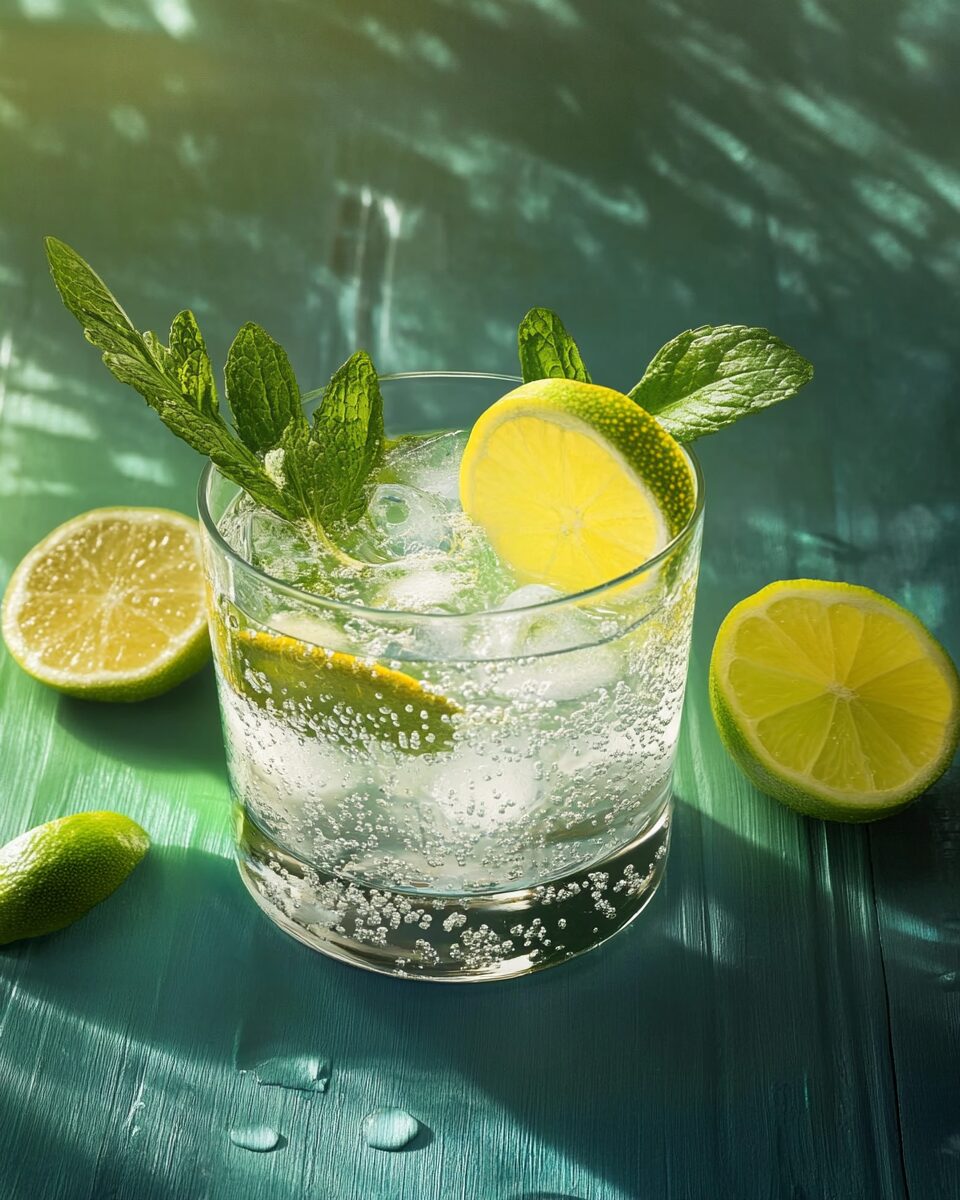The Gin & Tonic is a timeless cocktail known for its refreshing and crisp flavor. Originating in colonial India as a medicinal concoction, it has evolved into a beloved beverage enjoyed worldwide. The harmonious blend of gin’s botanical notes with the effervescence of tonic water makes it a versatile choice for various occasions.
Full Recipe:
Ingredients
- 2 oz gin
- Tonic water
- Lime wheels for garnish
Directions
- Fill a highball or rocks glass to the top with ice.
- Pour in 2 oz of gin.
- Top with tonic water.
- Stir gently to combine.
- Garnish with lime wheels.
Nutrients (per 100 ml serving)
- Calories: 73.6 kcal
- Protein: 1.85 g
- Carbohydrates: 4.25 g
- Fat: 0 g
- Saturated Fat: 0 g
- Cholesterol: 0 mg
- Calcium: 31.45 mg
- Vitamin C: 63.6 mg
- Folic Acid: 11.1 µg
A Brief History of the Gin & Tonic
The origins of the Gin & Tonic can be traced back to British colonial India during the 19th century. At the time, the British East India Company was involved in the administration of India, and one of the most common health concerns among soldiers and colonial officials was malaria. Quinine, a substance derived from the bark of the cinchona tree, was known for its ability to treat malaria, but it had a bitter taste that was hard to tolerate.
To make the quinine more palatable, British officers began mixing it with carbonated water, sugar, and lime, creating what was known as “tonic water.” Around the same time, gin was becoming a popular drink in England, and it was soon added to the tonic water, creating the cocktail we know and love today.
In the beginning, the Gin & Tonic was primarily consumed for medicinal purposes, but it didn’t take long for it to evolve into a popular recreational beverage. Its simplicity and refreshing nature made it a favorite among the British, and as British influence spread across the world, so did the Gin & Tonic. Today, it remains one of the most consumed cocktails globally, enjoyed for its perfect balance of bitterness, sweetness, and refreshment.
Why Gin & Tonic Has Stood the Test of Time
The enduring popularity of the Gin & Tonic can be attributed to several factors. First, its simplicity makes it easy to prepare at home or order at a bar. With only two main ingredients—gin and tonic water—this cocktail requires minimal effort while delivering a satisfying drink that can be enjoyed at any time of day.
Second, the versatility of the Gin & Tonic makes it adaptable to different tastes. Gin itself is a highly diverse spirit, with a wide range of flavors depending on the botanicals used in its distillation. From the classic juniper-forward taste to more contemporary gins that feature flavors like citrus, floral notes, or spice, there is a gin for every palate. This allows drinkers to tailor their Gin & Tonic experience to their personal preferences, making it an accessible choice for a wide variety of people.
The third reason for its lasting appeal is the way it strikes the perfect balance between sweetness and bitterness. The bitterness of the quinine in tonic water complements the aromatic qualities of gin, while the bubbles provide a refreshing effervescence that makes it a perfect drink for hot weather or casual gatherings. Whether it’s enjoyed as an aperitif or as a refreshing pick-me-up in the afternoon, the Gin & Tonic is a reliable and satisfying cocktail.
Gin: The Heart of the Cocktail
At the core of every Gin & Tonic is, of course, gin. The spirit itself has a long and fascinating history, which further enriches the story of the cocktail. Gin is made from distilled grain or malt and flavored with a variety of botanicals, with juniper berries being the most essential. Other botanicals commonly used in gin include angelica root, coriander, citrus peel, and herbs like thyme, rosemary, or lavender. These botanicals give gin its distinctive flavor, which can range from dry and crisp to rich and complex, depending on the recipe used by the distiller.
The choice of gin can dramatically change the character of the Gin & Tonic. For example, a classic London Dry Gin, with its prominent juniper flavor, will result in a more traditional, dry cocktail. On the other hand, a citrus-forward gin will add a bright, zesty quality to the drink, while a more floral gin will lend the cocktail an aromatic complexity. The growing trend of craft gins has expanded the options even further, offering unique flavors that can elevate a simple Gin & Tonic to a more adventurous and personalized drink.
Tonic Water: The Unsung Hero
While gin often steals the spotlight in the Gin & Tonic, tonic water is just as important in crafting a balanced and enjoyable drink. Tonic water is carbonated water that contains quinine, the bitter substance that gives the drink its distinctive flavor. The bitterness of quinine is essential in balancing the sweetness of the gin and providing the refreshing, slightly bitter taste that defines the Gin & Tonic.
Modern tonic waters come in a variety of styles, from classic formulations to more sophisticated, artisanal varieties that use natural botanicals and lower levels of sugar. These high-quality tonic waters can bring out the best in the gin, highlighting the botanicals and offering a more nuanced flavor profile. Some tonic waters even come in flavors like elderflower, ginger, or cucumber, which can add a creative twist to the classic Gin & Tonic.
For those who prefer a less bitter taste, there are also tonic waters available that have a reduced quinine content, resulting in a milder drink. Whether you prefer a traditional tonic or a more modern variation, the choice of tonic water is key to the final taste of the cocktail.
How to Customize Your Gin & Tonic
One of the best things about the Gin & Tonic is its ability to be customized. The basic recipe is incredibly versatile, and you can modify it to suit your tastes or to match the season. Here are a few ways you can put your own spin on the Gin & Tonic:
- Fruit Garnishes: While lime is the traditional garnish for a Gin & Tonic, feel free to experiment with other fruits. Lemon, grapefruit, and orange slices all pair beautifully with gin. For a more exotic touch, try garnishing with berries, cucumber slices, or even herbs like mint or basil.
- Herbal Infusions: Adding fresh herbs to your Gin & Tonic can enhance the drink’s complexity and aroma. Consider adding a sprig of rosemary, thyme, or basil to your glass for a refreshing, herbaceous twist.
- Flavored Tonic Waters: As mentioned earlier, there is a growing trend of flavored tonic waters. If you want to get creative, try a Mediterranean-style tonic water with hints of rosemary and lemon, or a pink grapefruit tonic for a zesty, citrusy punch.
- Gin Variations: Don’t be afraid to experiment with different types of gin. If you enjoy floral flavors, go for a gin made with botanicals like lavender or rose. For a more bold and spicy flavor, opt for a gin with strong notes of cardamom, cinnamon, or other spices.
- Bitters and Syrups: For an extra layer of flavor, add a few dashes of bitters, such as orange or Angostura bitters, or a splash of flavored syrup, like elderflower or honey syrup. This can elevate the drink from a simple cocktail to a more complex creation.
The Gin & Tonic in Modern Cocktail Culture
In recent years, the Gin & Tonic has enjoyed a resurgence in popularity, thanks in part to the growing craft cocktail movement. Bars and restaurants around the world have embraced the simplicity and versatility of the Gin & Tonic, offering it as a signature cocktail with unique twists and premium ingredients.
The Gin & Tonic has also become a symbol of sophisticated yet casual drinking. It’s often seen as a drink of choice for social gatherings, whether it’s a sunny afternoon barbecue, a relaxing evening on the patio, or an elegant cocktail party. Its easy-to-make nature and refreshing qualities make it the perfect drink for any occasion.
In addition, the rise of craft distilleries and the growing interest in mixology have led to a renewed focus on the quality of both the gin and tonic water used in the cocktail. Today, bartenders and home mixologists alike take great care in selecting the best possible ingredients to ensure the perfect balance of flavors in every Gin & Tonic.
Conclusion
The Gin & Tonic is more than just a cocktail—it’s a cultural icon with a fascinating history that has evolved over centuries. Its simple yet elegant composition, combined with its refreshing taste, has ensured its place as one of the most popular drinks in the world. Whether you enjoy it as a classic cocktail or experiment with different variations, the Gin & Tonic is a drink that can be enjoyed by everyone, from casual drinkers to connoisseurs.






